Modernism challenges traditional conventions in art, literature, and architecture, emphasizing innovation and a break from the past. It embraces abstraction, experimentation, and a focus on individual perception, shaping how we interpret culture and creativity today. Discover how Modernism continues to influence your world by exploring the rest of this article.
Table of Comparison
| Aspect | Modernism | Maximalism |
|---|---|---|
| Definition | Art movement emphasizing simplicity, minimalism, and function. | Art style focused on excess, elaborate detail, and layering. |
| Color Palette | Neutral tones, monochromes, limited colors. | Bright, bold colors, diverse and contrasting combinations. |
| Design Elements | Clean lines, geometric shapes, minimal decoration. | Ornate details, patterns, textures, complex compositions. |
| Philosophy | "Less is more" - focus on essential forms. | "More is more" - embrace abundance and extravagance. |
| Famous Artists | Piet Mondrian, Le Corbusier, Kazimir Malevich. | Yayoi Kusama, Gustav Klimt, Kehinde Wiley. |
| Impact on Art | Emphasized functionalism and abstraction. | Encouraged eclecticism and emotional expression. |
Understanding Modernism: Principles and Origins
Modernism originated in the late 19th and early 20th centuries as a response to traditional forms, emphasizing simplicity, functionality, and minimalism in design and art. Its principles prioritize clean lines, open spaces, and a neutral color palette to create a sense of order and clarity. Rooted in industrial advancements and a desire for innovation, Modernism marks a shift towards abstraction and rejection of ornate detailing.
The Essence of Maximalism: A Detailed Overview
Maximalism emphasizes bold patterns, vibrant colors, and layered textures to create visually rich and expressive spaces that celebrate creativity and individuality. Unlike Modernism's focus on simplicity, clean lines, and functional minimalism, Maximalism thrives on abundance, eclectic decor, and personalized design elements that evoke emotional depth and storytelling. This design ethos prioritizes diversity in materials and ornamentation, making each interior a dynamic and immersive experience.
Key Differences Between Modernism and Maximalism
Modernism emphasizes simplicity, clean lines, and functional design, characterized by neutral color palettes and minimal decor, whereas Maximalism embraces bold colors, eclectic patterns, and layered textures to create visually rich, expressive spaces. Modernist interiors prioritize open, uncluttered environments with a focus on form and efficiency, while Maximalism celebrates complexity, personal expression, and abundant ornamentation. The key difference lies in Modernism's discipline of "less is more" versus Maximalism's philosophy of "more is more," reflecting contrasting approaches to aesthetics and spatial organization.
Historical Evolution of Both Styles
Modernism emerged in the early 20th century as a reaction to traditional forms, emphasizing simplicity, function, and the rejection of ornamentation, influenced by movements like Bauhaus and De Stijl. Maximalism evolved later as a counter-movement, celebrating excess, bold colors, and eclectic textures, drawing inspiration from postmodernism and the desire for personal expression. Both styles reflect historical shifts in cultural and artistic values, with Modernism rooted in industrialization and minimalism, while Maximalism embraces complexity and visual abundance.
Color Palettes: Minimal Tones vs Vibrant Hues
Modernism emphasizes minimal tones with neutral shades such as whites, grays, and blacks, creating a clean, understated aesthetic that highlights simplicity and functionality. Maximalism embraces vibrant hues, incorporating bold, saturated colors like deep reds, electric blues, and bright yellows to evoke energy and visual richness. The contrasting color palettes define each style's identity, with modernism favoring subtlety and maximalism celebrating intensity and complexity.
Materials and Textures: Contrasts in Application
Modernism employs sleek, smooth materials such as glass, steel, and concrete, emphasizing minimal textures and clean surfaces to create a sense of simplicity and order. Maximalism contrasts with an abundant use of diverse textures including velvet, brocade, and layered textiles, blending natural elements like wood and stone with glossy metals for a rich, tactile experience. The juxtaposition of Modernism's restrained materials against Maximalism's opulent texture layering highlights their fundamentally different approaches to sensory engagement in design.
Iconic Designers and Influencers in Each Movement
Modernism in design is epitomized by iconic figures such as Ludwig Mies van der Rohe and Le Corbusier, whose minimalist philosophy emphasized functionality, clean lines, and the mantra "less is more." Maximalism, championed by influencers like Kelly Wearstler and Peter Marino, embraces bold patterns, rich textures, and a layered aesthetic that celebrates excess and visual complexity. These designers profoundly shaped their movements by redefining spatial relationships and aesthetic priorities, making Modernism a study in simplicity and Maximalism an exploration of decorative richness.
Modernism vs Maximalism in Contemporary Interiors
Modernism in contemporary interiors emphasizes clean lines, minimal ornamentation, and a neutral color palette to create open, uncluttered spaces that highlight functionality and simplicity. Maximalism contrasts this with bold colors, diverse textures, layered patterns, and eclectic decor, aiming to express personality and create visually dynamic environments. These opposing styles reflect differing design philosophies: Modernism prioritizes restraint and coherence, while Maximalism celebrates abundance and artistic freedom in interior spaces.
Pros and Cons: Finding the Right Style for You
Modernism offers a sleek, minimalist approach emphasizing clean lines and functional design, ideal for those who prefer simplicity and order but may feel too stark or impersonal for some tastes. Maximalism, characterized by vibrant colors, bold patterns, and layered textures, allows for rich personal expression and warmth but can risk overwhelming a space or appearing cluttered if not balanced carefully. Choosing between these styles depends on your desire for tranquility and minimalism versus energy and abundance, as well as the ability to maintain either a minimalist or richly decorated environment.
Future Trends: The Ongoing Dialogue Between Modernism and Maximalism
Future trends in design reveal an ongoing dialogue between Modernism's clean lines, minimalism, and function-driven aesthetics and Maximalism's bold patterns, vibrant colors, and layered textures. Emerging innovations in smart home technology and sustainable materials are increasingly integrated within Maximalist interiors, enhancing both visual complexity and environmental responsibility. This dynamic interplay is reshaping contemporary spaces, balancing Modernism's simplicity with Maximalism's expressive richness to create adaptive, personalized environments.
Modernism Infographic

 libterm.com
libterm.com